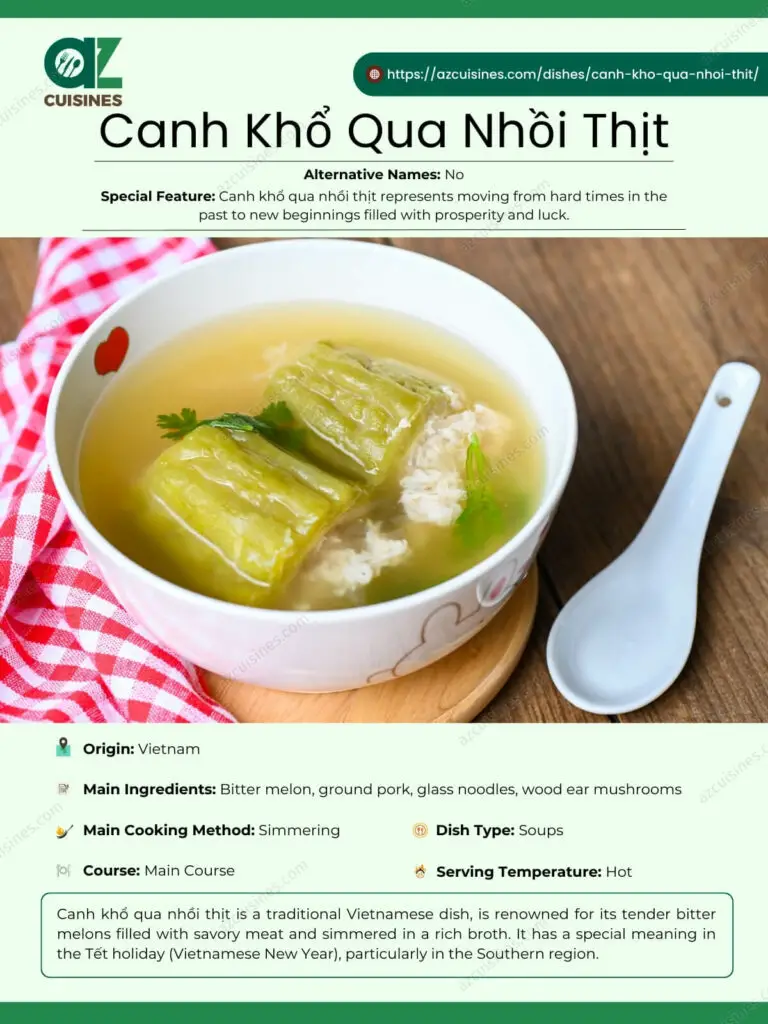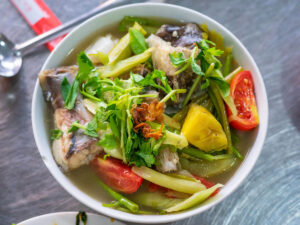#55 in Vietnam
Canh Khổ Qua Nhồi Thịt: Basic Information
Pronunciation
Alternative Name(s)
Dish Type
Course
Mealtime
Popular Canh Khổ Qua Nhồi Thịt Variations

Canh Khổ Qua Nhồi Cá Thác Lác

Canh Khổ Qua Nhồi Tôm

Canh Khổ Qua Nhồi Mọc

Canh Khổ Qua Chay

Canh Khổ Qua Tôm Khô
Canh Khổ Qua Nhồi Thịt: Ingredients and Preparation
Main Ingredients
Main Cooking Method
Preparation Process
Canh Khổ Qua Nhồi Thịt: A Deep Dive
Cultural Significance
Taste
Texture
Aroma
Color
Serving Style
Serving Temperature
Accompaniment
Occasions
Seasons
Special Diets
Calories
Popularity
Popular Similar Dishes
- Canh Bóng
- Canh Chua
Popular Dining Area
Canh khổ qua nhồi thịt (or stuffed bitter melon soup in English) is a traditional soup in the family meal in Vietnam, especially in the South region. It is also a favorite soup in the North and Central parts.
The key ingredient is bitter melon, known for its slightly bitter flavor. The bitter melon is hollowed out to be stuffed with meat.
The stuffing typically includes a mixture of ground pork, glass noodles (or bean thread noodles), wood ear mushrooms, shallot, and onions, seasoned with fish sauce (or soy sauce), sugar, salt, and pepper.
Once stuffed with the meat mixture, the melons are cooked in a clear pork or chicken bone broth. There is a vegan variation using pork imitation seitan noodles (called mì căn in Vietnamese) or tofu to make the stuffing.
Keep an eye out for upcoming insights about canh khổ qua nhồi thịt symbolic meaning in Vietnamese New Year, variations, health benefits of the key component, and good sides and potential downsides.
Additionally, I’ll address some frequently asked queries about this Vietnamese soup and its similar dishes. Read on!
Key Points
Canh Khổ Qua Nhồi Thịt Images
What is The Meaning Of Canh Khổ Qua Nhồi Thịt in Vietnam New Year?
Canh khổ qua nhồi thịt has been an indispensable soup during the Lunar New Year (aka Tết holiday) in Southern Vietnam.
The soup is a symbolic representation of the end of hard times and bad luck from the last year and the start of prosperity and luck that locals hope to get in the new year. The meaning is derived from the name itself, where “khổ” means “suffering or hardship” and “qua” means “to overcome or to pass.”
Moreover, bitter melon is easy to buy or grow all year round. Locals have several ways to create canh khổ qua in different styles. Continue the reading to explore the soup variations!
What Are Variations of Canh Khổ Qua Nhồi Thịt?
Canh khổ qua is versatile in Vietnamese meals, as a bitter melon can go with various cooking ingredients. Below are some ideal varieties to try once.

Canh Khổ Qua Nhồi Cá Thác Lác
Features a stuffing of ground bronze featherback fish.

Canh Khổ Qua Nhồi Tôm
Stuffed with a mixture of minced shrimp.

Canh Khổ Qua Nhồi Mọc
Contains Vietnamese pork paste stuffing, known as “mọc” or “giò sống.”

Canh Khổ Qua Chay
A vegetarian option stuffed with pork imitation seitan noodles or tofu.

Canh Khổ Qua Tôm Khô
A non-stuffed variation with sliced bitter melon and dried shrimp
Besides its versatility and deliciousness, bitter melons are a healthy food, making them a good choice for your diet.
What Are the Health Benefits of Bitter Melon in Canh Khổ Qua Nhồi Thịt?
Bitter melon (aka Momordica charantia) in canh khổ qua nhồi thịt is an amazing fruit with various vitamins and minerals. According to Healthline, the fruit is high in vitamins A and C, folate, antioxidant compounds, and fiber. Therefore, consuming bitter melon can bring back several health benefits, such as:
- Reducing blood glucose levels, which is good for people with diabetes.
- Controlling weight as it is low in calories and high in fiber.
- Improving skin health and the digestive system.
- Boosting the immune system with its high vitamin C content.
Next to the health benefits, there are some potential minuses of consuming bitter melon soup. Check out the next part for more insights.
Pros and Cons of Eating Canh Khổ Qua Nhồi Thịt
Let’s find out the benefits and drawbacks of indulging in canh khổ qua with the below table.
Pros
Cons
After weighing the pros and cons of canh khổ qua, you can check some common questions surrounding this soup.












Truc Tran (Kris)
Senior Food Editor
Expertise
Home Cooking, Meal Planning, Recipe Development, Baking and Pastry, Food Editor, Cooking-video Maker, Vietnamese Food Evaluation Expert
Education
Truc Tran (Kris), an experienced food writer and editor, is great at exploring and describing global cuisines, from simple street food to fancy dining. In her writing, she skillfully mixes different flavors, cooking methods, and culinary traditions, showing the unique character of various cultures through their food and drinks. On azcuisines.com, Kris highlights her knowledge, especially in Asian cuisine and worldwide traditional dishes.